
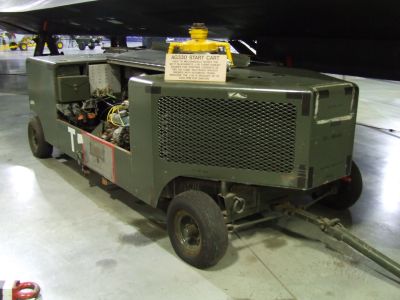

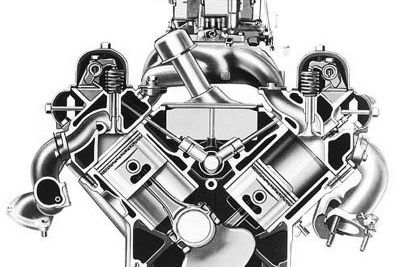
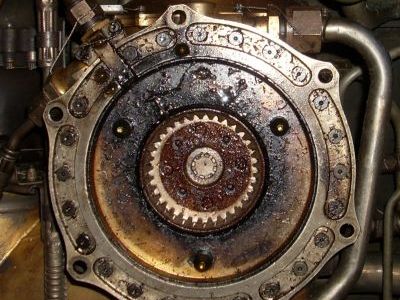
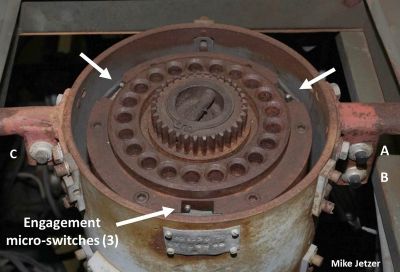
(Mike Jetzer, Heroic Relics)
The J58 Start Cart
by Tom Fey
Published 5 Nov 2015; Revised 28 Nov 2015
AEHS Conventioneers have had the opportunity to view the A-12/SR-71 and the Pratt & Whitney J58 engine at several of our annual meetings. The achievements of the airframe and its integrated propulsion system are legendary, but it was at this year's Convention that I got a chance to examine yet another of the J58's unique systems.
The New England Air Museum has a J58 in their storage hangar, and I happened to standing near it when Pete Law said to someone "… and the starter drive and bypass trunk should be right under here." So I crawled under the engine and started flashing away with my camera. Sure enough I found the starter drive fitting as well as the bypass trunk which had been disconnected and wrapped closed.
The starter receptacle has a central splined coupling with three stout, conical-tipped pegs that engage the housing of the start cart probe.
The AG330 Start Cart
In the early days the J58 was started with an external AG330 "Start Cart". The earliest iteration used dual Buick 401 cubic inch V-8s with automatic transmissions driving a gearbox. Emerging from the gearbox was a vertical drive dog that engaged a fitting on the underside of the J58. The combined V-8s would deliver 600-650 horsepower, and spin the engine up to a self-sustaining 3,200 rpm. Ignition of the low-volatility, flash-resistant JP-7 fuel required a shot of triethylborane (TEB), which ignites spontaneously upon exposure to oxygen. Later versions of the AG330 used 454 cubic inch Chevy LS-7 engines (425 horsepower each). The ultimate J58 starting arrangement employed a hangar-based Garrett AirResearch compressed air system, which drove a turbine that engaged the engine starter dog.
 |
 |
 |
| Lockheed M-21 Variant of the A-12 with Pratt & Whitney J58 at the Museum of Flight in Seattle, Washington. (Tom Fey) | AG330 Start Cart at Hill Aerospace Museum, Hill, Utah. (Jaydec at English Wikipedia) | Dual 401 cubic inch, 325 horsepower (each) Buick Wildcat “nailhead” V-8 engines coupled together in the AG330 at the Seattle Museum of Flight. (Tom Fey) |
 |
 |
 |
| Buick “nailhead” V-8. Note the vertical valves and steep angle in the head, which necessitated small diameter valves, similar to an inverted 16 penny nail, thus the name “naihead”.(Curbside Classic) | J58 Starter Receptacle on the Ventral Surface of the J58 at the New England Air Museum. Splined Drive Receptacle in Center with Alignment Pegs Located at 10, 1, and 6 o ’clock. (Tom Fey) | AG330 probe head with central drive gear surrounded by receptacles for the alignment pegs. Note micro switches that confirm proper mating of the probe and starter pad. A) Up switch, B) Down switch, C) Presumed to be Probe Brake Release switch. (Mike Jetzer, Heroic Relics) |
Retired Colonel Rich Graham flew the SR-71 for seven years and rose to Squadron and Wing Commander of the 9th Strategic Reconnaissance Wing at Beale AFB, California. Col Graham kindly put me in contact with Crew Chief Master Sergeant Dave Burns, USAF, retired. Dave spent eight years as Maintenance Crew Chief for the SR-71 at Beale and Kadena AFB, Okinawa. Dave was able to provide additional detail on how SR-71 engine starts were accomplished using the early model "Buick" AG330 start cart.
Each of the two Buick V-8s had eight straight exhaust pipes that exited out of the bottom of the AG330. Each engine had a Hydromatic transmission with electric shift, and the two transmissions were coupled together by a 12 inch wide, toothed Gilmer belt. The coupled engines drove a gearbox that turned the output 90° to the vertical for the probe head. This gearbox was hydraulically controlled and had a chip detector that would trigger a warning light on the AG330 control panel if metal debris was detected in the gearbox. The control panel was located at the end of the AG330. Each engine had ampere, water temperature, oil pressure, and oil temperature gauges, a tachometer, a start switch, large chrome choke control handle, and engine oil overpressure override button. Water temperature, oil pressure, and oil temperature gauges had red limit warning lights.
The probe instruments included green indicator lights for Probe Engaged, Starter Ready, Transmission Shifted, Probe Disengaged, and Probe Brake On. Toggle switches for the probe included Engage Probe, Disengage Probe, Probe Brake release, Jet Start, and a guarded Cart Shutdown switch. A single Morse throttle controlled both start cart engines; idle was at the top of the throttle travel, moving through Run and Advance as the throttle was moved downward. Probe gauges included Jet Speed and Torque Pressure.
On the far right side of the Instrument Panel were a Cart Positioning lever, which could be used to move the whole cart left or right on the chassis frame to align the probe, a master Power On indicator light, Elapsed Time Hobbs meter, Main Power toggle switch, Main Power circuit breakers, and a Number of Jet Starts gauge (missing in the photographs). The Hobbs meter indicates this cart had 408.5 hours on the Buicks.
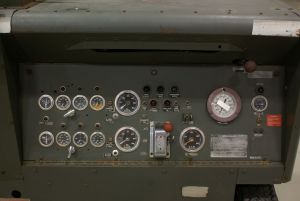 |
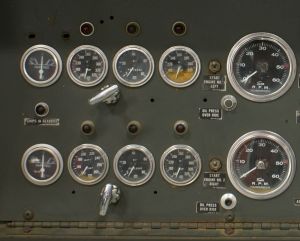 |
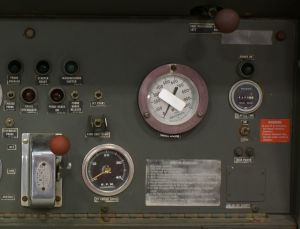 |
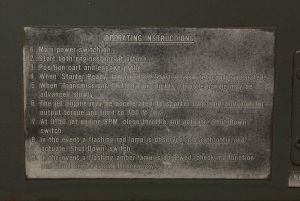 |
| AG330 Control Panel (Mike Jetzer, Heroic Relics) | AG330 Control Panel Engine Gauges (Mike Jetzer, Heroic Relics) | AG330 Control Panel Probe Gauges(Mike Jetzer, Heroic Relics) | AG330 Control Panel Operating Instructions (Mike Jetzer, Heroic Relics) |
The probe head had two handles. The right side handle had two switches; the top switch raised the probe while the lower switch lowered the probe. Retraction was passive by venting the hydraulic pressure. The left handle had a single switch, which may have released the probe brake. The drive gear was approximately three inches across and had a surrounding fitting with holes that received the three alignment pegs on the engine drive pad to align the probe. The probe could gimbal approx. 1/4 to 1/2 inch to account for slight misalignment from true vertical between the cart and the engine pad. There were three microswitches on the probe head that all had to close to confirm proper probe placement, and this was indicated by two green "Probe Engaged" and "Starter Ready" lights on the start cart panel. This would arm the probe.
The Buick engines were started ahead of time and warmed up in neutral. The curved starter drive access panel, approximately 15 x 30 inches and attached by CalFax fasteners, was opened, the cart positioned, and the probe raised to mate with the drive pad. Maximum vertical probe travel was about 24 inches, but a loaded airplane typically required a vertical travel of 8 to 10 inches. The starter pad is only an inch or two inside the outer surface of the aircraft.
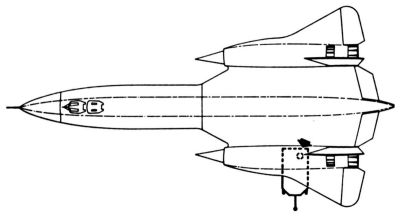 |
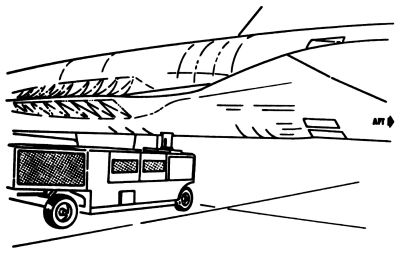 |
| AG330 Start Cart Positioning (Mike Jetzer, Heroic Relics) | AG330 Start Cart Engaged (Mike Jetzer, Heroic Relics) |
Engine Starting Procedure
The pilot told the Crew Chief via intercom "Engage Buicks". The Buick operator pressed "Jet Start", and movement of the Buick throttle (one throttle lever controls both engines) downward engaged the transmissions. The "Transmissions Shifted" illuminated green, and the Buicks started to load up.
It was important for the Buick operator to accelerate but maintain 700 to 725 lb ft of torque during starting procedure. Too high a torque pressure would cause the probe to drop out, which prevented overstressing the gear box, but resulted in a "cut off throttle" command from the Crew Chief to the pilot. With the Buick disengaged and the jet engine unable to sustain itself, the risk of an over temperature condition was high. Since the probe could not be re-engaged to a spinning J58, it was imperative to quickly re-engage the probe once the J58 wound down to motor the jet engine and blow out any fire. Too low a torque pressure during Buick start would cause a lag in acceleration to idle speed and an over temperature condition.
The pilot would watch his onboard gauges to confirm minimum oil pressure, fuel pressure, and rising RPM, and then set the jet throttle to idle. At that point 30cc of TEB was injected into the burner cans, a characteristic green flame was emitted, the J58 lit off, accelerated and started to run on its own. The accelerating jet started to unload the Buicks, and when 3,200 rpm was reached, the pilot called "Buicks out", the Crew Chief signaled "cut", the Buick operator hit "Cart Shutdown", the probe fell free passively, and the cart throttle automatically returned to idle.
Neither the J58, the probe, nor the start cart transmission contained an overrunning clutch, so it was important that the probe fall free. If it hung up, the crew had to quickly get in and shake the handles as fast and as hard as they could. The Buicks would reach 4,800 to 4,900 rpm, the redline on the start cart, just to get the J58 to 3,200 rpm. Overspeeding of the Buicks caused by a probe hang-up contributed to the occasional thrown connecting rod and oily parts dropping out from under the cart. Idle speed for the J58 is 3,950 rpm, which could drive the Buicks to over 6,000 rpm. The potential for engine failure, as well as the Buick exhaust stream, required the crew to stand only at the ends, not aside, the start cart.
Later in the program a Garrett AirResearch air start turbine system was used, supplied by a large volume, low pressure air supply. For the air start system, the J58 starter pad had an adapter plate that engaged lugs on the air starter turbine housing. The turbine assembly was about the size of a laundry hamper and had two handles. It was hung on to the J58 starter pad by two men with about a two-inch turn to secure it, then locked it into place with a safety grip latch. Two large air flex hoses were attached, and then high volume, 60 psi air was admitted to spin the turbine for engine start. Once the J58 started, the two air flex hoses were removed, the two crew members grabbed the handles, unlocked the lever, and rotated the starter off the pad. The turbine was still spinning, causing a gyroscopic effect which could torque the starter out of an unwary crew's hands. For use of the air starter outside of Beale, a special manifold was required that combined the output of four standard air start carts to supply the air start turbine.
Restarting a J58 in the air was rare and could be accomplished by the wind milling engine, but specific conditions of altitude and airspeed had to be met. Also, the onboard supply of TEB to light off the JP-7 was 600 cc for each engine which allowed a ground start and up to 16 afterburner ignition sequences. The cockpit had a "TEB Remaining Counter" to keep track of the TEB, but there was a platinum catalytic ignition system in the afterburner to back up the TEB system.
Mike Jetzer's excellent site, with photography way better than mine, can be found here:
http://heroicrelics.org/info/sr-71/ag-330-start-cart.html
A video that has clear audio of a J58 start accompanied by still photographs of the AG330 can be found here:
https://www.youtube.com/watch?v=JjdyQpEUYzI
Another video shows a whole SR-71 start and launch sequence. The air start tubrine can be seen at about 1:00.
https://www.youtube.com/watch?v=hZIGKwhQ8dw
Acknowledgements
It is interesting to me that the J58s from the world's fastest airplane were started by mechanical means not too dissimilar from the Hucks system used in the 1920s. I thank Dave Burns for sharing his knowledge, Mike Jetzer for the use of his photographs, and Rich Graham for his wonderful books on the SR-71.